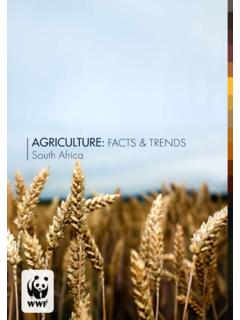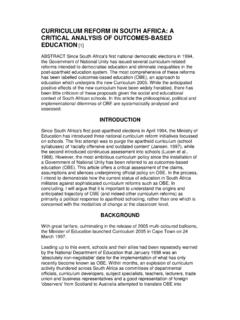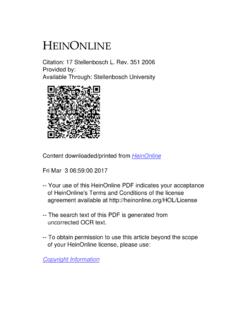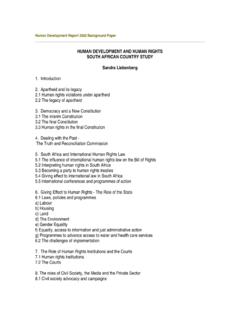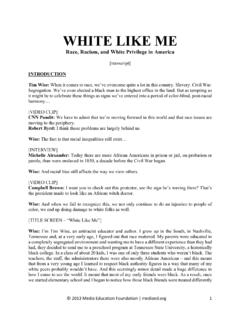Transcription of TRADE UNIONS IN AN EMERGING ECONOMY The Case of …
1 TRADE UNIONS IN AN EMERGING ECONOMY . The Case of south africa HAROON BHORAT. KARMEN NAIDOO. DEREK YU. DPRU WORKING PAPER 201402. JULY 2014. TRADE UNIONS IN AN EMERGING ECONOMY . The Case of south africa DEVELOPMENT POLICY RESEARCH UNIT. HAROON BHORAT. KARMEN NAIDOO. DEREK YU. Working Paper 201402. ISBN 978-1-920633-04-2. July 2014. DPRU, University of Cape Town 2014. This work is licenced under the Creative Commons Attribution-Non-Commercial-Share Alike south africa License. To view a copy of this licence, visit or send a letter to Creative Commons, 171 Second Street, Suite 300, San Francisco, California 94105, USA. ABSTRACT. This paper provides a historical overview of the south African TRADE union movement, followed by a brief discussion of the labour market legislation and institutions formed since 1994.
2 Thereafter, a detailed evaluation of the impact of TRADE UNIONS , legislation, and institutions on labour market outcomes in south africa is provided, and it is found that despite a long history, TRADE union membership levels, their impact on average wage levels, and their pursuit of strike action, has resulted in relatively benign economic impacts within country and relative to other economies around the world. The political- ECONOMY effects shaping the country's employment relations are then discussed. JEL Classification Codes: F50, J30, J51, J52. Keywords: TRADE UNIONS , labour market efficiency, wage premium, strikes, political ECONOMY , south africa Acknowledgements This paper was prepared for the Oxford Handbook of africa and Economics' authors'. conference in Beijing, 8-10 December 2013, implemented with UNU-WIDER, World Institute for Development Economics Research (UNU_WIDER), Katajanokanlaituri 6 B, 00160.
3 Helsinki, Finland, Working Papers can be downloaded in PDF (Adobe Acrobat) format from A. limited number of printed copies are available from the Communications Manager: DPRU, University of Cape Town, Private Bag X3, Rondebosch, Cape Town, 7700, south africa . Tel: +27 (0)21 650 5701, email: Corresponding author Prof. Haroon Bhorat, Director of the DPRU. Tel: +27 (0)21 650 5705. email: Recommended citation Bhorat, H., Naidoo, K. and Yu, D. (2014). TRADE UNIONS in an EMERGING ECONOMY : The Case of south africa . Development Policy Research Unit Working Paper 201402. DPRU, University of Cape Town. Disclaimer The Working Paper series is intended to catalyse policy debate. They express the views of their respective authors and not necessarily those of the Development Policy Research Unit (DPRU).
4 CONTENTS. 1. INTRODUCTION 2. 2. THE south AFRICAN TRADE UNION MOVEMENT: A Brief History 2. 3. THE POST-1994 ENVIRONMENT: From Legislation to Labour Market Institutions 6. 4. THE IMPACT OF TRADE UNIONS AND LABOUR LEGISLATION ON LABOUR 10. MARKET OUTCOMES IN south africa . 5. THE POLITICAL ECONOMY OF HIGH UNEMPLOYMENT 16. 6. CONCLUSION 18. REFERENCES 19. DPRU WORKING PAPER 201402. 1. INTRODUCTION. As an upper middle-income country within africa and the continent's largest ECONOMY , south africa often attracts specific interest in terms of its economic growth and development dynamics. This is of course also in part a function of the country's unique history, based on the notorious system of apartheid . Often under-appreciated is the extent to which this history of racial segregation and discrimination has generated so many of the outlier features of this ECONOMY .
5 From high levels of spatial segregation and a very small informal ECONOMY , to extraordinary economic and social inequalities amongst the citizens of the country, and a surprisingly deep-inherited social assistance scheme south africa remains a country of unusual and unexpected statistics. Nowhere is this feature more evident than in the labour market of this ECONOMY . Perhaps the most relevant outlier statistics lie in the areas of unemployment and income inequality. In the case of the former, south africa has had an average unemployment rate, since 1994, of about 25 per cent. This unemployment rate remains one of the highest in the world. The figure has a low standard deviation over the sample period and for the immediate future is unlikely to change significantly. In terms of income inequality, the latest estimate for 2010 places the Gini co-efficient at , ranking south africa as one of the most unequal societies in the world today.
6 Underlying this high inequality is the notion that the moderate economic growth rate since 1994, averaging at per cent per annum, has yielded a modest poverty reduction, but sharp rises in household inequality (Bhorat and van der Westhuizen 2013). At the heart of the debate around the country's twin peaks' of unemployment and inequality is the role played by the labour market in generating unequal returns, as well as large quantity-based disequilibria. The role then, played by wages and institutions in the labour market in generating these outcomes has been a focus of research in these areas in south africa (Armstrong and Steenkamp 2008; Bhorat et al. 2009b; Bhorat et al. 2012a; Bhorat et al. 2012b). In this paper we attempt to consider the role played by institutions in the south African ECONOMY with a focus on the TRADE union movement and the labour-regulating architecture of the country.
7 The paper thus first provides a historical overview of the south African TRADE union movement before and after the end of apartheid , followed by a brief discussion of the labour market legislation and institutions formed since 1994. Thereafter, there is a detailed evaluation of the impact of TRADE UNIONS and wage legislation on labour market outcomes in south africa . Before concluding, the paper culminates in a discussion on the political- ECONOMY effects shaping south africa 's employment relations in light of the tripartite structure of the ruling governmental party. 2. THE south AFRICAN TRADE UNION MOVEMENT: A BRIEF HISTORY. The Union of south africa , formed in 1910, was characterized by a political partnership between English-speaking and Afrikaans-speaking whites, representing their mining and agricultural interests respectively.
8 The Union formally excluded the African majority from any formal political expression. 1 A series of laws were passed that would deleteriously impact on the smooth functioning of the labour market. For instance, the 1911 Mines and Works Act reserved skilled mining jobs for whites, while the 1913 Land Act forbade Africans from owning land in designated white' areas and resigned Africans to reserves', accounting for only seven per cent (increasing to 13 per cent later) of the total land area of the country. Also, the Pass Laws curtailed the free flow of African labour, thereby forcing many African workers into low-wage sectors and occupations (Van der Berg and Bhorat 1999; Woolard 1. There are four population groups in south africa , namely African, coloured, Indian, and white. African, coloured, and Indian individuals are collectively referred to as black.)
9 2. TRADE UNIONS in an EMERGING ECONOMY : The Case of south africa 2001). As a result, the labour market was characterized by a strong racial division of labour that would persist for decades to come. The core foundation of collective bargaining legislation in south africa was the Industrial Conciliation Act of 1924, which provided for the voluntary establishment of permanent collective bargaining institutions, namely Industrial Councils (ICs), by employers'. organizations and registered non-African TRADE UNIONS (Godfrey et al. 2010). Within its legal ambit, for the first five decades after being established, the ICs denied African workers access to centralized collective bargaining, and despite the lack of racial representation within the bargaining structures, it could set minimum wages for the sectors concerned.
10 Since only non-African TRADE UNIONS were recognized and allowed to negotiate, they were in a favourable position to protect the wage interests of their non-African members. Needless to say, this reinforced discrimination against Africans as they were placed outside the ambit of IC agreements (Nattrass and Seekings 1997; Butcher and Rouse 2001; Rospab 2001;. Woolard 2001). The Industrial Conciliation Act was amended in 1930 by stipulating that the agreements reached at the IC could be extended by the minister of labour to all workers (including Africans) in the industry concerned, regardless of whether the workers belonged to the TRADE union(s) participating in the negotiation. Although this amendment did improve wages of African workers, the real aim was to protect the jobs and living conditions of white workers, given that the 1924 act unintentionally incentivized employers to dismiss white employees and replace them with African employees at lower wages (Godfrey et al.)




